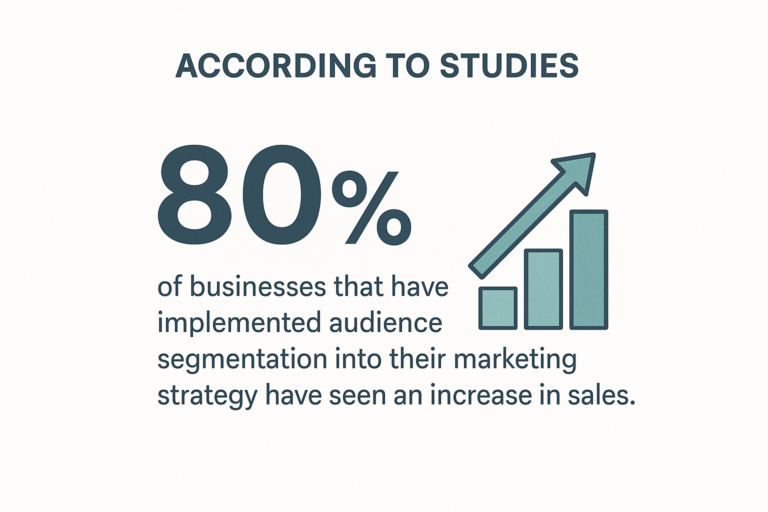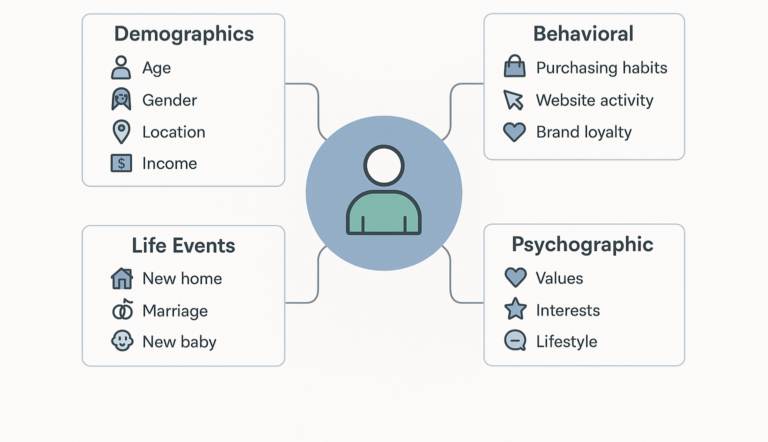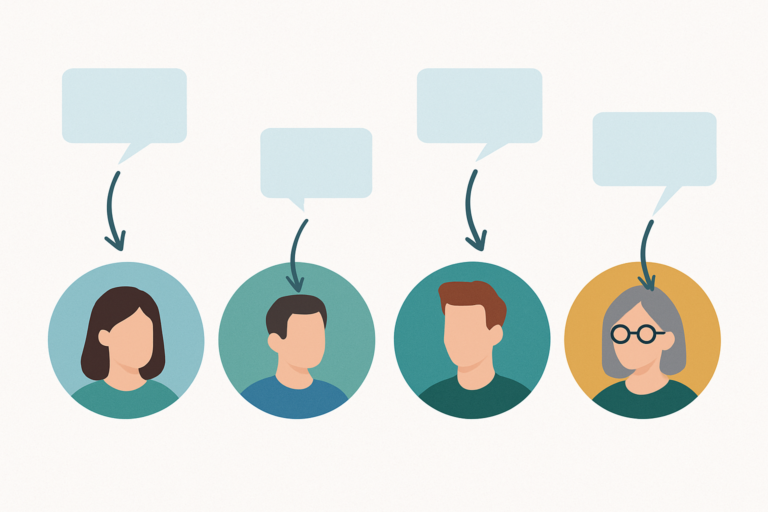What’s all the hype about audience segmentation about? Is it useful? Well, imagine casting a wide net into the ocean, hoping to catch a specific type of fish. You might pull in a few of the right ones, but you’ll also waste time and resources hauling in plenty you don’t need.
That’s how traditional marketing worked. It allowed you to reach a large audience, however, many of them were never truly interested or even the right fit.
Today, audience segmentation offers a more innovative alternative: by dividing your audience into specific groups based on shared characteristics. Businesses can now deliver relevant messaging that resonates, improve conversions, and build stronger customer relationships.
Why Audience Segmentation Matters
According to a recent study, 80% of businesses that have implemented audience segmentation into their marketing strategy have seen an increase in sales. This statistic highlights the significance of segmentation in driving revenue growth and improving overall marketing effectiveness.
Audience segmentation ensures that your messaging resonates with your audience by speaking to their interests and needs. Therefore, customers engage more with your business. Another key benefit is that you’re not wasting your marketing budget on an audience that is not interested.

5 Audience Segmentation Types
Segmentation involves categorising your target audience by shared characteristics to create campaigns targeted to those segments.
There’s no one-size-fits-all approach to segmentation, but some of the most popular methods include:
Demographic Segmentation
Segments your audience based on attributes such as age, gender, income, education level, occupation, or family status. As an example, if you are in the luxury cosmetic industry, you may want to target women in their 30s with disposable income.
Behavioural Segmentation
Group consumers based on their online behaviour, such as browsing habits or buying history. For instance, retargeting website users who have visited your website or have items in their cart.
Psychographic Segmentation
Centres around customers’ lifestyles, values, beliefs, interests, and personality traits to understand what motivates their decisions. Such as, sportswear brands target health-conscious individuals.
Geographic Segmentation
Target the audience by their location. This is ideal if your business serves a specific area, such as a beauty salon. A franchise may create campaigns targeting different areas.
Life Events
Target users when they reach life milestones such as becoming a parent or planning a wedding.

The Importance of Personalisation
Personalisation ensures your messaging is personal, creating the sense that you’re talking directly to your customer.
Here are some ways to incorporate personalisation in your marketing strategy:
Personalised Email Campaigns
Addressing the customer by name and sending them an email based on previous interactions with your brand. As an example, if they’ve visited a specific product page, you can send them deals and offers relating to that product.
Relevant Product Recommendations
Suggest products based on a user’s browsing or buying history, for example, recommending similar products to the ones in their cart.
Dynamic website content allows you to show website content based on customer data such as paid ads that generate dynamic titles based on the user’s search.
Personalised Ads
Ad campaigns that speak to audience segments based on location, interest, and behaviour. For instance, if a user has shown interest in marathon training, your business might show them running shoes.

Audience Segmentation Tips
These tips will help you make the most out of your marketing strategy:
Keep it Simple
If you’ve just started, you can test the waters by targeting one or two primary audience segments. For instance, you could target two different demographics, such as parents and young professionals.
Make Use of Insights
Google Analytics and Meta’s Audience Insights are free tools you can use to determine which audience segments are most successful. For example, analysing which segments are already engaging with your content.
Use A/B Testing
A/B testing refers to comparing different elements of your campaign to see which works best and which best aligns with your audience.
For example, you can post two ads with different ad copy to see which one your audience segments engaged with most.
The Power of Retargeting
Retargeting is an effective tool for converting users who have already shown interest in your business but have not yet become customers. This strategy is all about bringing users back and guiding them further down the buying journey.
The Marketing Rule of 7 states that, on average, a potential customer engages with a brand 7 times before making a purchase. This rule illustrates the importance of retargeting your ideal customer for driving conversions.
Below is a simple step-by-step guide:
The first step is to analyse your customer behaviour data and categorise your audience into segments based on their previous interactions with your brand, such as casual browsing vs. leaving items in their cart. Tools like Google Analytics or Meta Pixel can give you valuable information on your audience’s behaviour.
Using the data and your customer segments from the first step, you’re equipped to create ads that convert. For example, if a segment of users viewed a product’s pricing, a compelling ad offering a discount for that product could entice them back.
Consider diversifying your retargeting content in the form of blog posts, videos, live demos, dynamic, and social media ads.
Last but not least, remember your existing customer base. Businesses often underestimate the value of retargeting existing customers. Not only is it good for sales, but it also nurtures brand loyalty. This strategy allows you to customise your messaging to speak directly to your customers, for example, showing ads for products they are interested in, special offers, rewards, and sneak peeks into special releases.
Tools for Audience Segmentation
Customer segmentation tools give you valuable insights into your customer behaviour. They provide data, help you identify patterns, provide visual interpretations, and divide your audience into segments.
Here are the common tools most marketers use:
Google Analytics: The platform allows you to create, customise, and manage customer segments. It’s a powerful tool for understanding your audience, identifying your most successful segments, and optimising your campaigns.
Meta Audience Insights: Audience segments in Facebook’s Ad Manager allow you to explore and create segments based on demographics, interests, and behaviours, allowing you to tailor your messaging to these groups.
Email Marketing Tools: An excellent tool for sending personalised messages and automating your campaigns based on user data. For example, sending personalised emails offering loyal customers an exclusive deal.
CRM Platforms: Customer Relationship Management system can also be a powerful tool in your marketing strategy toolkit. The centralised database of customer information facilitates laser-focused, highly targeted communication and product recommendations.
4 Segmentation Mistakes to Avoid
Here are a few commonly overlooked mistakes to keep an eye out for:
The Bottom Line
The first step to any strategy is outlining clear goals. Without clear objectives such as increasing sales, customer experience, and tailored messaging, it’s hard to create relevant segments.
Targeting too broadly or too strictly (over-segmentation) leads to a waste of your ad spend; the trick is to find the right balance for manageable segment audiences.
Not monitoring and updating segments regularly to stay up to date with market and behavioural changes.
Only relying on one metric, such as demographics. Combining demographics with behavioural, psychographic, and geographic data allows for a more targeted approach.
Hopefully, these audience segmentation strategies have guided you in understanding and connecting with your audience in a more meaningful way. From getting noticed to building lasting loyalty, implementing an effective audience segmentation strategy can be a game-changer for your marketing efforts.
However, with that said, there is no single formula for audience segmentation. It highly depends on your industry and your unique customer profile. Finding the right segmentation strategy often requires testing and refining over time.
If you’re unsure of the best strategy for your business or are not getting the results you hoped for, drop us an email at company@snowballcreations.com or get in touch via our webform. We’d love to chat.